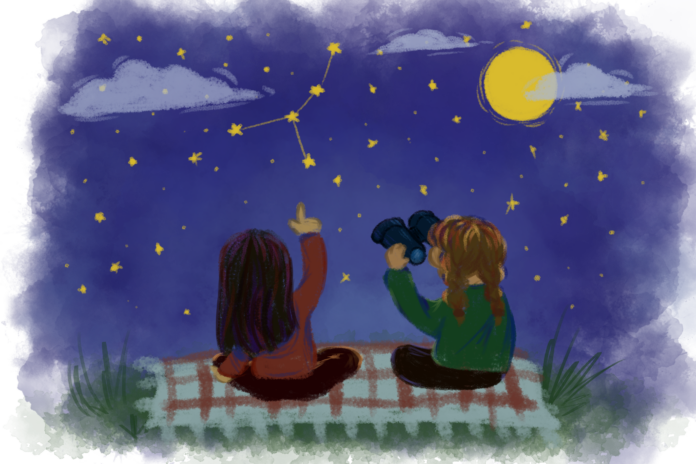Students and staff discuss view of the universe, hope to involve students of all backgrounds in the field
By AMBER WARNKE — features@theaggie.org
The stars have been objects of fascination for as long as humans have been around to see them — and the students and faculty at UC Davis are no exception. UC Davis offers a variety of ways students can learn about astronomy, including lower-division courses open to all majors, physics and astronomy clubs on campus and occasional speaker events.
Kathryn Galdamez, a fourth-year physics major and vice president of the Physics and Astronomy Club at UC Davis, assists in coordinating public and private viewing events. The club provides telescopes at these events and guides viewers on what they are seeing in the night sky.
“Being able to learn and then making that kind of information digestible to the public — I think that’s what really keeps me in physics,” Galdamez said.
Public viewings are accessible to all students regardless of major and occur two to three times in fall and spring quarter, but they are not held during winter quarter due to less ideal weather.
Galdamez also said that joining the Physics and Astronomy Club is an accessible way for students to learn more about astronomy. The club is currently planning a visit to Lick Observatory near San Jose, which is owned by the University of California, as well as a Women in Physics Q&A Panel on Feb. 14 and a Physics Picnic day show, information on which can be found on the club’s Instagram: @astronomyatucdavis.
Lynn Hironymous, a fifth-year physics major and project team lead of the Physics and Astronomy Club, expressed appreciation for the experience that the club has provided to him.
“Last time we had a viewing, we pointed [the telescope] at Orion’s nebula, which is just under the belt of the Orion constellation, and got a really nice picture of the nebula,” Hironymous said. “We also could see with our own eyes the milky spurt where new stars are being born.”
Hironymous pointed out that the club is open to all majors and explained how studying the night sky has changed his view of the universe.
“This is just this small section of our universe and there’s millions of galaxies surrounding that,” Hironymous said. “I take up such a small portion of it, but it doesn’t make me feel small; It makes me feel like my problems are less and that I can handle what I’m doing.”
Galdamez holds a similar view, sharing that studying astronomy has forced her to take a step back and understand the bigger picture of her life.
“Earth is exactly what it needs to be away from the sun in order to have life here, and I think that makes us pretty special,” Galdamez said. “I think that should motivate us to really make the most of [life].”
Patricia Boeshaar, a professor in the Department of Physics and Astronomy at UC Davis with a Ph.D. in astrophysics, believes that astronomy has the potential to benefit students across UC Davis.
“I think we tend sometimes to get overwhelmed with the immediate, instead of putting everything into perspective,” Boeshaar said. “And that’s what [astronomy] helps you do.”
Boeshaar’s career has allowed her to see incredible astronomical events, including one instance on Feb. 23, 1987. She was working on the four-meter telescope in Chile at the time, when she experienced the first supernova seen on the Earth since the 17th century.
“I have to tell you, being there at the time was really, really exciting,” Boeshaar said. “It’s just serendipity.”
Boeshaar has been fascinated by the stars since 1952, when she received a book about them for Christmas at five years old.
“Women were not expected to do science in the ‘50s, but I really wanted to do it,” Boeshaar said. “I was first generation.”
Despite societal views, Boeshaar was determined to study astronomy.
“Back then, they thought of me more or less as, ‘You go get the donuts, you go get the coffee,’” Boeshaar said. “But I knew what I wanted to do.”
Galdamez has similarly experienced a lack of representation in her field.
“As a woman, as hispanic, as someone of the queer community, it’s really hard to find role models in these kinds of spaces,” Galdamez said. “If I’m able to do it, then I hope someone else sees it and is like, ‘Oh maybe I could do it, too.’”
For students hoping to learn more about astronomy, a free public lecture will be held at the UC Davis Conference Center on March 4 by Nobel laureate Adam Riess, who is known for discovering evidence that the expansion of the universe is accelerating. There will be a reception at 6 p.m., followed by the lecture at 7 p.m.
Students looking to experience astronomical events firsthand should also prepare for a total lunar eclipse on March 13, 2025, starting at 8:57 p.m. Totality will occur at 11:58 p.m., and the eclipse will last until March 14 at 3 a.m.
Boeshaar shared what a lunar eclipse is and what to expect.
“When you have a lunar eclipse, the moon goes through the Earth’s shadow,” Boeshaar said. “The moon typically turns blood red because the Earth scatters out the blue light and what the atmosphere bends around tends to be the leftover red light.”
On other nights this quarter, students can look for Orion, Gemini, Taurus, Ursa Major, Andromeda and the Pleiades, which can be spotted in the sky until late March. In conclusion, to quote the motto of the Physics and Astronomy Club: “Keep looking up!”
Written by: Amber Warnke — features@theaggie.org





